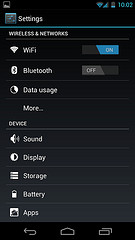To understand why Nexus 7 can show more content than the Galaxy Nexus, I'll first explain two concepts: screen density and density-independent-pixel.
But before we go into technical details, it may be worth to clarify the design goals of using density-independent-pixels. The goal is to define a UI that is similar in dimension across devices, regardless of the screen size. So in this case the appearance of the menus is the same in the Galaxy Nexus and the tablet (side by side should look very similar), but, as one has a bigger screen, more content can be shown. The designer selects an appearance that looks good for a certain size (a 160 dpi screen is the base) and this is "simulated" in this case in devices with higher dpi.
Screen Density
Commonly referred to as dpi (dots per inch). Android groups all actual screen densities into four generalized densities: low (120), medium (160), high (240), and extra high (320). A device such as Galaxy Nexus has "extra high" screen density (more specifically, the dpi value is set at 320). The Nexus 7 uses "tvdpi" - i.e. 213 dpi.
Density Independent Pixel
Commonly referred to as dp. This is the virtual pixel unit used when displaying content. The density-independent pixel is equivalent to one physical pixel on a 160 dpi screen. To calculate dp use the following formula:
px = dp * (dpi / 160)
or equivalently:
dp = (px / dpi) * 160
The reason Nexus 7 can show more content than the Galaxy Nexus despite having similar resolutions is this: the dpi of Nexus 7 is lower than Galaxy Nexus.
Galaxy Nexus (320 dpi, 720 pixels wide)
(720 / 320) * 160 = 360 dp
Nexus 7 (213 dpi, 800 pixels wide)
(800 / 213) * 160 = 600 dp
This means that when apps are rendering on the Galaxy Nexus, the width of the screen is actually 360 dp (rendered using 720 pixels). Whereas on the Nexus 7, the width of the screen is 600 dp (rendered using 800 pixels).
Bonus
If your Galaxy Nexus is rooted, you can use an app such as LCD Density Modder and change the DPI of your device to 240. What you'll get is something a lot closer to Nexus 7 in a smaller package. On the left is a screenshot of the device at 240 dpi. You'll notice we can see a lot more content when the DPI is lower.


Nothing to do with PPI
The other answers mention PPI. The amount of content displayed has nothing to do with the PPI of a device. Though commonly, vendors select the DPI that is closest to the PPI of the device. (e.g. Galaxy Nexus has a PPI of 316, but a DPI of 320, where as Nexus 7 has a PPI of 216, but uses a 213 DPI).
Further Reading
http://developer.android.com/guide/practices/screens_support.html


